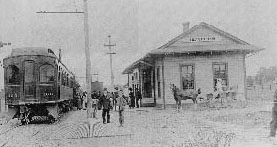Beaverton Central Area History
 By 1913, business was booming on the Oregon Electric Railway. The Beaverton Depot had been enlarged and extended with new siding. A wooden loading dock had also been added. The Oregon Electric ran nine trains daily from Portland through Beaverton and on to Forest Grove.
By 1913, business was booming on the Oregon Electric Railway. The Beaverton Depot had been enlarged and extended with new siding. A wooden loading dock had also been added. The Oregon Electric ran nine trains daily from Portland through Beaverton and on to Forest Grove.
Natural setting
The land that Beaverton Central Station sits on, and the area around it, was originally a low-lying area fed by many creeks and springs. Beavers were attracted to the marshes and lush forests that covered the landscape. They dammed creeks and streams, creating large ponds and lakes across the valley. Successive generations of beavers built and rebuilt these dams until the area was part forest, part beaver haven.
Native Americans
Local Native Americans of the Atfalati tribe made their winter campgrounds in the Tualatin Valley and had continuously occupied the area prior to the arrival of European trappers in the 1780s. By the time Lewis and Clark reached the area in 1805, the Native Americans had been ravished by successive waves of venereal fever, respiratory disease, malaria and smallpox epidemics that had swept the Pacific Northwest.
Railroad
The town site of Beaverton was platted in 1868, though the town wasn’t incorporated until 1893. The founding fathers created a village centered around the two railroad lines that ran through it.
Over the years, a number of railroads have provided different focal points for the town, including early steam railroads, the Oregon Electric and Red Electric interurban lines, two diesel freight lines, Burlington Northern and Southern Pacific and, now, MAX light rail.
The Oregon Electric Railway provided service from downtown Portland to Beaverton and as far as Forest Grove on a branch off the main line at Garden Home. MAX light rail generally follows the former Oregon Electric right-of-way from Beaverton to Hillsboro. This right-of-way was de-electrified in the 1940s and then was mainly used by Burlington Northern [BN]. After many years of negotiations with the city, BN vacated the line in the 1980s.
Commerce
Beaverton’s historic downtown area lies south of Canyon Road from the station. In addition to shops and services, the downtown once included a variety of small industries supporting agriculture in the Tualatin Valley and electric railroad car maintenance.
The horseradish farms of Rose Biggi, the founder of Beaverton Foods Co., covered much of the station area from the late 1920s until the middle of the 1950s. A sewage treatment plant replaced the farms and remained there through the mid-1970s, when it was dismantled.
From 1920 to 1925, Premium Picture Productions made about 15 movies from a studio located on a 33-acre site along SW Erickson. Locals often appeared as movie extras. After bankruptcy brought the demise of the movie studio in 1925, the large frame building and accompanying 33 acres on Erickson Avenue was converted into the Watts Airport. This airport was soon moved to Charles Bernard’s farm field, now the site of the Beaverton Mall. On Sept. 11, 1938, The Oregonian called it “perhaps the busiest noncommercial airport in the United States … where exists the added distinction that most of the planes are amateur-built.” It remained there until 1969 and was the oldest continuously operated airport in Oregon.







